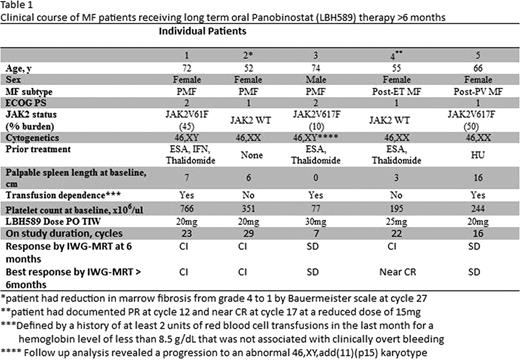Abstract
Abstract 794 FN2
FN2
LBH589 is a novel pan-deacetylase inhibitor (DACi) that has demonstrated clinical activity in phase I/II studies in patients with a variety of hematologic malignancies. Our group has previously presented preliminary results of a phase I study of LBH589 in patients with myelofibrosis (MF) (Mascarenhas et al, ASH 2009, a308) while a phase II trial using higher doses of LBH589 has also been reported (DeAngelo et al, ASH 2010,a630). Both studies identified reversible thrombocytopenia as the DLT and reported evidence of clinical responses. The final results of our phase I study and the effects of extended treatment with LBH589 are reported here. We enrolled 18 patients at 3 dose levels. Fifty-five percent of these patients had PMF, 28% Post-PV MF and 17% Post ET MF; all were intermediate/high risk based on Lille classification. Twenty-five mg PO TIW was determined to be the recommended phase II dose. All patients experienced resolution of their systemic symptoms and 10/11 patients with baseline palpable splenomegaly, who were evaluable after 1 month of therapy, had a median reduction of 30%, range 0–100%. Five patients entered into an extension phase of the trial and received > 6 months of therapy with a mean dose of 20mg PO TIW at time of optimal response (Table 1). Of these patients, 2 were initially enrolled in the 20 mg PO TIW cohort, 1 in the 30 mg PO TIW cohort and 2 in the 25 mg PO TIW cohort. Both patients at the lowest dose achieved clinical improvement (CI) by IWG-MRT response criteria at 6 months as did one patient at the 25 mg dose. The remaining 2 patients had SD at 30 and 25 mg. A mean reduction in palpable splenomegaly at 3 and 6 months of 55% and 83%, respectively, was observed in this group. Two of these patients had marked and durable improvement in anemia (patients 1 and 4). Patient 4 achieved a near CR at 16 months with resolution of palpable splenomegaly, elimination of peripheral blood dacrocytes and leukoerythroblastosis, a 4g/dL increase in hemoglobin, improvement in overall marrow cellularity and megakaryocyte atypia with an increase in erythroid precursors and a significant reduction of reticulin/collagen fibrosis. Patient 1 was heavily transfusion dependent requiring RBC transfusions weekly to maintain a mean hemoglobin of 6.5g/dL and after 6 months on LBH589 achieved >50% reduction in transfusion dependence maintaining a mean hemoglobin of 9g/dL. Patient 2 had resolution of palpable splenomegaly and leukoerythroblastosis by cycle 6 and the bone marrow at cycle 26 was characterized by a reduction in marrow fibrosis from grade 4 to 1. A phase II study is ongoing, 14 patients are currently enrolled, with a planned goal of 22 patients. Pharmacokinetic and pharmacodynamic studies as well as cytokine profiling of the phase I patients are being analyzed and will be presented at the meeting. We conclude that low doses of LBH589 delivered for greater than 6 months in patients with MF are capable of ameliorating symptoms, improving clinical features and reversing pathologic marrow changes.
Disclosures:
Off Label Use: Oral histone deacetylase inhibitor that targets epigenetic changes in malignant myelofibrosis cells with an goal to modify the disease process.
Author notes
*
Asterisk with author names denotes non-ASH members.

This icon denotes a clinically relevant abstract
© 2011 by The American Society of Hematology
2011


This feature is available to Subscribers Only
Sign In or Create an Account Close Modal